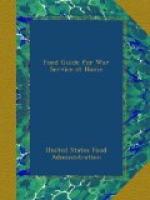“Why not send corn abroad?” One hears the question over and over again. The answers are many. In the first place, we are sending corn over—our exports of corn during March, 1918, increased 180 per cent and of corn meal 383 per cent over the pre-war average. This they are using as we are using it in our Victory bread. But they must have enough wheat to make a durable loaf of bread at the bakeshops, where for generations all the baking has been done. The French housewife has no facilities for bread-making and the French woman does not know how and has not the time to learn. She is doing a man’s work and her own woman’s labor besides, and the extra unaccustomed labor of bread-making cannot be added to her burdens.
WHY WE IN THE UNITED STATES DO NOT HAVE BREAD CARDS
Some people, disturbed either selfishly or patriotically by the failure of a neighbor to conserve wheat, have asked why the Food Administration trusts to voluntary methods, why it does not ration the country.
Rationing may come yet, but any such system bristles with difficulties. The cost to the Government has been variously estimated all the way from $10,000,000 to $45,000,000 a year. Fifty per cent of the population could not be restrained in their consumption by rationing, for they are either producers or live in intimate contact with the producer. A wheat ration which would be fair for the North might actually increase the consumption in the South. Finally, the burden of a bread card would fall largely not on the well-to-do, who eat less wheat already and can easily cut down further, but on those with little to spend, who might have to change their whole food habits.
The success that is meeting our method of voluntary reduction of consumption “will be one of the remembered glories of the American people in this titanic struggle.”
CHAPTER IV
THE MEAT SITUATION
Meat shortage is not a war problem only. We had begun to talk of it long before the war, and we shall find it with us after peace is declared. Great production of beef can take place only in sparse settlements. As the tide of increasing population flows over a country, the great cattle-ranges are crowded out, giving place to cultivated fields. More people means less room for cattle—a relative or even absolute decrease in the herds.
WHERE EUROPE’S MEAT HAS BEEN PRODUCED
In spite of their crowded territory, the majority of European countries have raised most of their meat themselves, though usually they have had to import fodder to keep up their herds. They have been less dependent on import for meat than for wheat. Great Britain is the only country which has imported much meat—almost one-half her supply. Her imports, and to a lesser extent those of other European countries, have come chiefly from Denmark and Russia in Europe, and from six countries outside—the United States, Canada, Argentina, Uruguay, Australia, and New Zealand.




